
|   |

|   |
Natya Kala Conference 2011 Text & pics: Lalitha Venkat, Chennai e-mail: lalvenkat@yahoo.com January 4, 2012 The 31st Natya Kala Conference convened by Shanta Dhananjayan got off to a flying start with a packed hall at Krishna Gana Sabha on Dec 26 morning. The dates for Natya Darshan seminar and NKC fortunately did not clash, so it was convenient for rasikas to enjoy both conferences. The NKC 2010 and NKC 2011 have been dedicated to projecting the teaching methodology of known and less known natya traditions. This year the conference was dedicated to Thanjavur Vadivelu and natyacharya Vazhuvoor Ramaiah Pillai. Following a brief presentation by Kamala Lakshminarayan’s disciple, Narthaki Nataraj, ardent disciple of Kittappa Pillai, presented Navasandhi Kauthuvam, saying it was auspicious for Brahmotsavam in the temple and hence for the conference too. 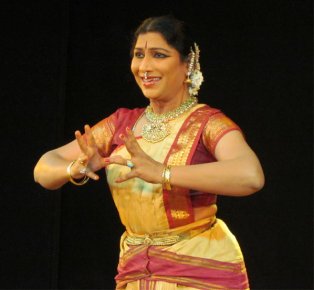 Narthaki Nataraj 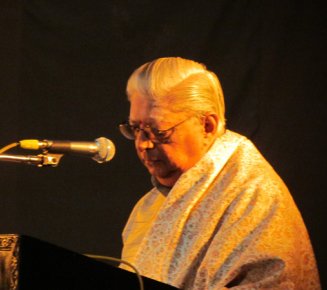 BM Sundaram Scholar BM Sundaram spoke on the contributions of Vadivelu. He started by pointing out that the dais had photographs of Meenakshisundaram Pillai and Ramaiah Pillai but Vadivelu’s pic was glaring in its absence in a conference dedicated to him. (On the last day, Shanta Dhananjayan clarified that these 2 photos had been brought by Kamala!). Though it’s good to know how dance was in days gone by, like the orchestra standing behind a dancer and playing, sampradaya need not be stagnant. When you are right, no one remembers and when you are wrong, no one forgets! Through discussions on dance, many absurdities can be removed. Sundaram pointed out tidbits of erroneous information present about Vadivelu. Only Chinnaiah and Sivanadam were disciples of Meenakshisundaram Pillai, not Vadivelu. He excelled in playing the violin and the king gifted him an ivory violin that is still preserved in Thanjavur. About 41 of his compositions are available and he composed the pada varnam “Chaalamela,” not Swati Thirunal. It has been said that Vadivelu had no children but that was not so. He had a daughter, who had 2 sons – Chidambara nattuvanar and Swaminatha nattuvanar. Born on Oct 8, 1810, Vadivelu lived in Thiruvananthapuram and died there on Sept 21, 1847. Sujatha Vijayaraghavan spoke about the Vazhuvoor legacy. When Ramaiah Pillai was given the Natya Chakravarthy title, he said Nataraja was the lord of dance and turned it down. He accepted when the title was changed to Natya Kala Kesari (a lion in dance), a title that truly suited him. He was rooted in bhakti, his family being asthana musicians of the Vazhuvoor temple. He adapted himself to the times. The venue was no more the temple or durbar, the children were not all from devadasi community and even the audience for dance had changed. So he changed the form of the repertoire. That was his major contribution. He was well versed in Tamil and Telugu. His recitation of jathis was unforgettable as the jathis themselves danced when he recited them. He had learnt the karanas and instead of using them for mere poses, they became part of movement. Though nattuvanars never danced, Ramaiah had learnt dance and music too, so music was instilled into him. He got musicians to compose for him and choreographed many Tamil varnams as he was keen to introduce as much Tamil as possible to appeal to audiences in Tamilnadu. He was a Tamil scholar and wanted to explore Tamil literature. Defying law, he choreographed about Bharatiyar for the stage. When he choreographed Thyagaraja’s “Saadhinchaney” on Kamala as a bhakti piece, a scholar objected to it. Ramaiah said, “You find bhakti in music, I find bhakti in Bharatanatyam. Behold it as a traditional art form and you will find bhakti in it.” VAK Ranga Rao was probably his only male disciple, said Sujatha. Like a disciple needs a good guru, a guru also needs good disciples to showcase his/her choreography and he had a handful of star students like Chitra Visweswaran, Padma Subrahmanyam, Rhadha to project his legacy. 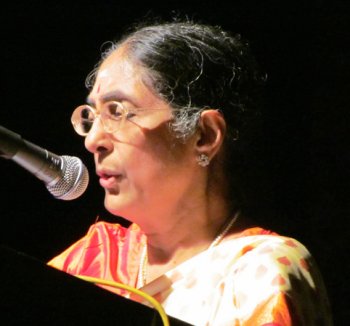 Sujatha Vijayaraghavan 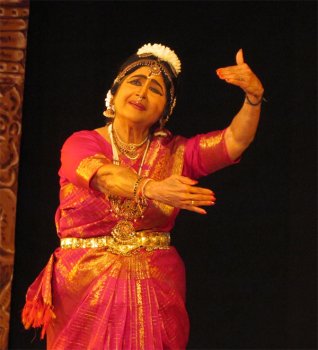 Kamala Lakshminarayan The biggest star of them all was Kumari Kamala, who could be called one of the key figures of the renaissance of Bharatanatyam, “transforming overnight what was loathsome into laudable.” Kamala had her arangetram when learning under her first guru Kattumannarkoil Muthukumara Pillai in the Thanjavur style and then moved on to learn from Guru Vazhuvoor Ramaiah Pillai, who built on her earlier training. Ramaiah Pillai and Kamala were a team unto themselves. Apart from slides of the guru, we saw film clips of a very young Kamala dancing in ‘Sri Valli,’ ‘Naam Iruvar’ (“aaduvomay pallu paaduvomay”), ‘Konjum Salangai,’ as Sivakami in ‘Parthiban Kanavu.’ Watching Kamala’s dance and Sivaji Ganesan’s reactions for “Naan unnai ninaikkatha neram undo” in ‘Paavai Vilakku’ was thoroughly entertaining. The audience was ecstatic and clapped as if actual items were being performed! When Kamala emerged on stage in a dark pink dance costume, the joy of the rasikas knew no bounds as she performed for “Oru mugam salithaal” and “Kaa vaa vaa” accompanied by Rajeswari, her vocalist of 41 years. Since she was only 8 when she trained under Ramaiah Pillai, he would first give her short jathis, explain the situation, steps and abhinaya to her and she would do a tremendous amount of practice to do better in class. She urged the young generation to work as hard. She and her guru formulated some new adavus that were integrated into the choreography and what we see today is the amalgam of a given tradition with the inspiration of a great master and a great pupil working in tandem. Kamala concluded with the demo of jathis done in “Saadhinchaney” to standing ovation. Manikka Vinayakam, the son of Ramaiah Pillai, is now a leading composer in films. He shared memories of his father, who used to stammer till he was 7 but was cured of it after prayers at Palani temple. Bharatanatyam is a leading art form and to preserve and propagate it goes to a few banis, one being the Vazhuvoor bani and he was proud his respected father belonged to it. Many varnams and padams were choreographed by his father and in his trademark jathis, the words formed a dance of their own. Ramaiah Pillai would start with small jathis at the start of an item, increase in the middle and have long jathis near the finale. Manikka Vinayakam never really learnt from his father and what he gathered was only in passing. His formal training was from Samraj. He recited some interesting sequences of jathis that were highly appreciated by the audience. 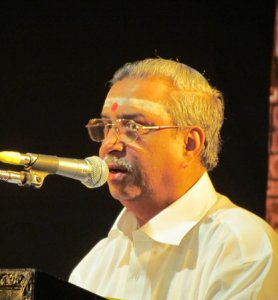 Manikka Vinayakam 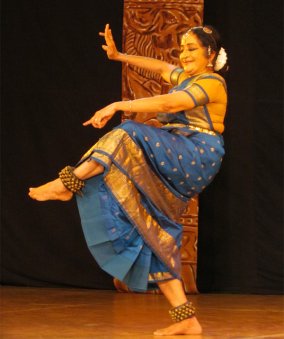 Rhadha Clad in a blue costume, Kamala’s sister Rhadha performed “Karunai seidhaal aagaadha,” a composition of Papanasam Sivan, followed by a fantastic rendering of ‘Natanamadinar’ made famous by Kamala. The leg lifts, leaps, floor movements on her knees elicited admiring applause since the dancer would turn 70 on Dec 31. “The Vazhuvoor style emphasizes beauty in movements, curves, glides and smooth slides rather than technically correct but aesthetically less pleasing stiffness.” Next was a surprise item by Rhadha and Padma Subrahmanyam for “Maalai pozhudhinile oru naal,” a composition of Kalki Krishnamurthy, immortalized by MS Subbulakshmi. Rhadha as the young girl and Padma as Muruga were utterly charming. “If I am dancing today, it is because of her. I watched her dance as I grew up,” said Padma Subrahmanyam of Kamala. Complimenting Rhadha on her exquisite mandi adavus and paichal adavus that morning, Padma said EV Saroja was another inspiration those days. When they were young, they would attend performances of senior dancers with their guru. He would say that the more dances you see, you will become a better dancer and the more music you hear, you will become a better musician. Swamimalai Bhagavathar was Ramaiah Pillai’s spiritual guru. Though he had a big puja room, he would do his puja in the dance class as the dancers would be rehearsing. He loved dogs and they would be all over the place, but he urged his students to concentrate on practice without getting distracted by them! Light footed grace marked his compositions. He would bring in other teachers like Mylapore Gowriammal to teach abhinaya. Padma then performed a delightful excerpt from her kurathi role in ‘Viralimalai Kuravanji.’ 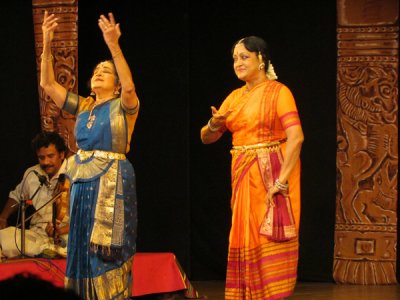 Rhadha & Padma Subrahmanyam 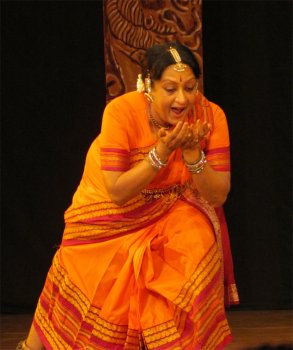 Padma Subrahmanyam Chitra Visweswaran spoke about her learning experience. Growing up in Kolkata, she learnt the Thanjavur style of Bharatanatyam till she was nineteen. Watching Kamala’s dance, Chitra wanted to learn from her guru but wondered whether he would have time to teach her since he was extremely busy conducting and choreographing for Kamala. “I have been fortunate that he himself danced and taught me. He took care to weave striking of sculptural poses into movement to make them part of the adavus. He made me aware of the beauty of nature and drew our attention to the colors in nature. Even when describing a movement he would say dance like a deer or bend like a creeper. When performing mudras, don’t do them mechanically. Think that you are gathering flowers, show each one to the audience. Invite them to appreciate their fragrance. He was a visionary. He did many things that others did not dare to. Rajalakshmi was my acharya, Ramaiah Pillai was my guru.” 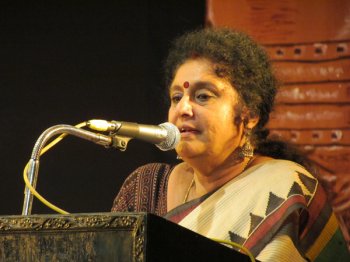 Chitra Visweswaran 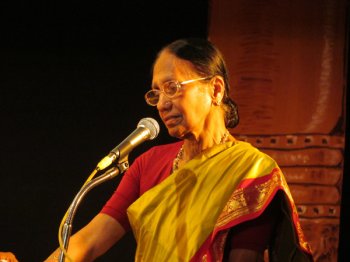 Tripurasundari Yoganandan The final speaker was Tripurasundari Yoganandan from London, who was Ramaiah Pillai’s first Srilankan disciple. After hearing his recitation of jathis and seeing Kamala dance, she wanted to learn from him, so she came to Chennai in 1956. In 1958, she had her arangetram at Jaffna with her guru conducting her debut performance. He was both her guru and a father figure. After seeing her perform, many in Srilanka wanted to learn Bharatanatyam from Ramaiah Pillai. It was a scintillating morning, with everyone sighing in nostalgia, but rather long as the session extended past 2pm. The morning of Dec 27 was devoted to Yakshagana by Idagunji Mahaganapati Yakshagana Mandali led by its director Keremane Shivananda Hegde. The form of Yakshagana they perform belongs to the Badagu style of north Kanara in coastal Karnataka and is more expressional with limited dialogues. It is composed of classical as well as folk elements. The purvaranga is the start of the recital and is performed before start of the prasanga or story that begins after some rituals in the green room and Ganesha vandana. Each character has its own entry style in Yakshagana and the first character enters the stage after that. Training for character roles takes 5 years at least. The students learn different talas and ragas, then movements and character entries. Yakshagana has lots of debates and dialogues, so with some editing, emphasis is laid more on movement and expressions and less on dialogues. For cutting down the dialogues making the form more dance and music oriented, Keremane Shivananda Hegde has come in for some criticism. 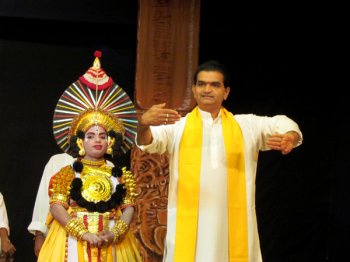 Keremane Shivananda Hegde 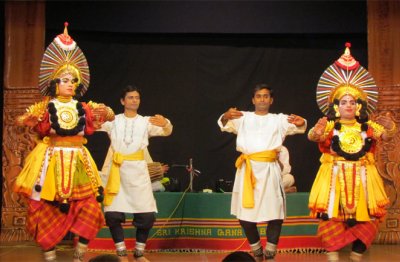 Idagunji Mahaganapati Yakshagana Mandali 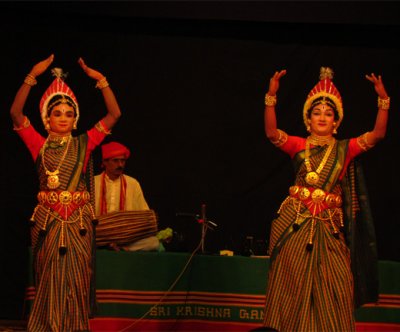 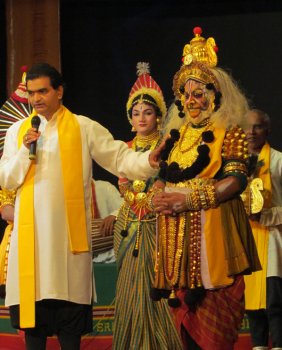 Hanuman character The gorgeous costumes are based on the essential nature of the characters and have been designed by anonymous artists of yore. There are various types of headgears and crowns for the different characters as well as different types of armbands and waist bands. Just by looking at the makeup or mukha varnike, one can distinguish the identity of the character. The artistes do the makeup themselves. Theirs is an all male troupe and the artistes are not necessarily from hereditary families but drawn from various backgrounds. The guru admitted that he had to pull youngsters into the art and some come from poor background. The demonstrations and dance sequences were a big hit with the audience, who were still talking about the wondrous Hanuman and demon characters and the female impersonation over the following mornings. An energetic morning. On Dec 28, we got to see the lyrical beauty of Manipuri in the demo by Manipuri Kendra, Imphal, led by Lokendrajit Singh. We also got to see how learning Manipuri martial art Thang Ta is integral to a Manipuri dancer as many of the dance movements are a softer version based on the martial art movements and stances. They started by showing their version of surya pranam where the different positions indicated the different cardinal directions. Another exercise involves leaping sidewise. Every house has 2 pillars between the 2 walls and the artiste has to train for martial art by leaping along the side from one pillar to another. The next exercise was like on the spot jogging involving a jump, twist to the side with arms stretched out, squat, rise up and back to position. In the 2 types of lotus hand movement, mostly the right twist of fingers is used and Singh demonstrated that with swords. 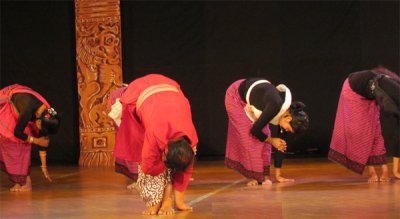 Surya vandana 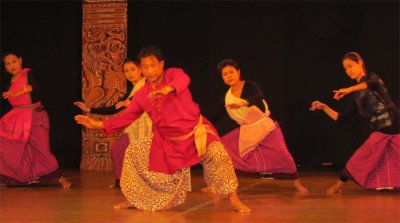 Artistes of Manipuri Kendra 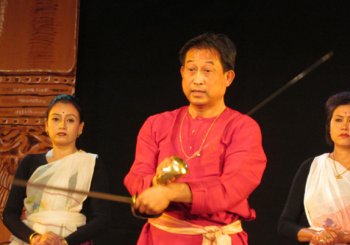 Artistes of Manipuri Kendra 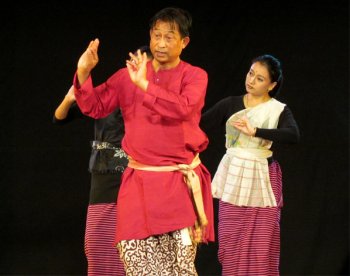 Artistes of Manipuri Kendra For foot movements, 3 imaginary points of a triangle are used in one sequence. How this is used in martial art and its softer usage in dance was shown. Next was a combination of hand gestures and foot movements, also using swords. Exercise for the thighs used in martial art is useful when portraying Krishna. Body straight, it involves bending the knees at 3 different levels. Patterns of movements used in Lai Haroba were a gentle flow of movements. It’s said there are 385 kinds of serpentine formations. The hand movements in Bharatanatyam and Kathak are pointed but in Manipuri, they are soft. For curved movements, the body line is also curved. Technique of talas in Manipuri style and different types of talas were demonstrated by the dancers. Singh also mentioned that there being 7 different clans, one could distinguish by the patterns of the dhotis the men wore. One sees dance sculptures in the temples of Tamilnadu, Karnataka and Orissa but in Manipur’s Gobindaji temple, there’s only a sculpture of Krishna, so poses have to be imagined. A Bengali song “Neela kamaladala Shyam” was presented followed by Lokendrajit Singh and Laxmi Devi presenting a Basant Raas duet on Krishna. Ankle bells are not used, hence movements are softer. It was an eye opener to see how martial art stances and hand gestures are used in Manipuri dance, and hence the exercises done by the Manipuri dancers are of Manipuri martial art exponents. We soon realized that the slow movements look deceptively simple and is anything but that! The female vocalist’s high pitched singing and modulation brought the final topic to music. Regarding Manipuri music, it is neither Carnatic nor Hindustani but closer to Malaysian or Thai music with Chinese influences since many Chinese settled in Manipur, hence even their facial features are different. Singh said along with the high pitch and voice modulations, even sobbing is part of the music when emotions run high. The sequence of items of a performance has been recently evolved. The presence of the Manipuri troupe at the conference was sponsored by the Central Sangeet Natak Akademi, Delhi. Day 4 of the NKC was devoted to Mohiniattam lec-dem by Kerala Kalamandalam by V Kaladharan under the guidance of Guru Kalamandalam Leelamma. As we waited for the program to start, I overheard a group of overseas visitors complaining about how auto fares in Chennai have doubled compared to last year! Kaladharan started with a brief history of Kerala dance forms, about how Kathakali has borrowed from Krishnattam and Koodiyattam, but Mohiniattam is sandwiched between Krishnattam and dance theater Kathakali, thus posing a challenge to keep its distinct qualities. The dance form does not have a hoary history. Though there was a practice of devadasi tradition, there is no evidence of its connection to present day Mohiniattam. It is also not established that Mohiniattam was performed at the court of Swati Tirunal. The dance performed at royal courts and landed people could have been Mohiniattam. Dasiattam was not banned in Kochi but the English educated shunned the corruptions in Mohiniattam like dancers sitting on the laps of patrons/chieftains. In a book written by Chathu Nair, there is even a chapter on Mohinis performing at the houses of chieftains and staying there. Since the elitist in Kerala had disowned Kathakali as well as Mohiniattam, when Vallathol started Kerala Kalamandalam, all these turbulences were there and he had a hard time finding a Mohiniattam dancer. Thotassery Chinnammu Amma’s recollections were primitive and Mohiniattam was built on that. In 1950s, Mohiniattam was revived and incorporated in Kerala Kalamandalam and many innovations were made, like Kalyanikuty Amma’s wearing the hair like a bun. Kaladharan said Mohiniattam has so many practitioners trying to make so many innovations, even to the extent of loud aharya that has become so colorful and garish, as well as exaggerated facial expressions that it goes against the basic elegance of the form. 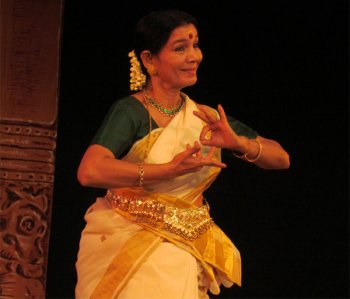 Kalamandalam Leelamma 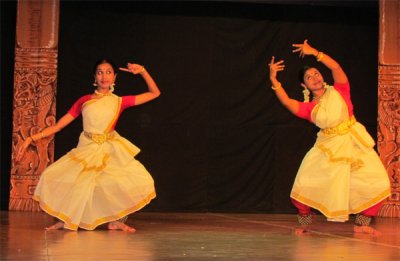 Artistes of Kerala Kalamandalam 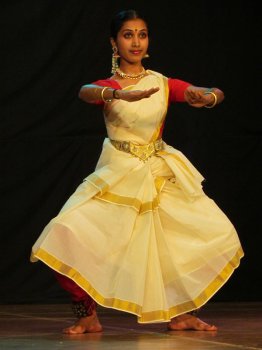 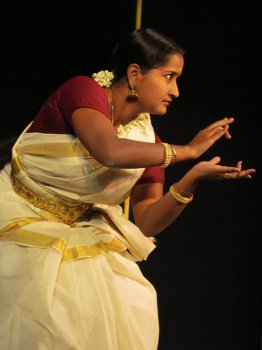 After the namaskar, physical exercises were demonstrated. Adavus are categorized into sets and examples from each set were shown. Hand gestures are taken from the Hasta Lakshana Deepika of an unknown author and the 24 gestures were demonstrated. Using pataka, a dancer described a beautiful garden, the plants and creepers and the 2 romantic parrots on a branch. Changes in angika abhinaya seen in the old and new varnam formats were depicted. Leelamma presented a new varnam she has composed, about the appeal by Meera to Lord Krishna followed by a padam demo by a disciple, and completed with a thillana. While Kaikottikalli also has influenced Mohiniattam, the influence of Bharatanatyam is a matter of concern, said Kaladharan. The Q & A session was interesting. How much more or less should torso movement be? Since many Christians learn Mohiniattam, use of Mohiniattam for Christian themes - Leelamma has composed an item on Christ and Kerala Kalamandalam was the first to democratize the dance form. Is Mohiniattam stuck in tradition with no opportunity to evolve? “From the 70s, there has been substantial growth. Vocabulary has been improved, variations have come in like dance dramas. For doing contemporary themes in Mohiniattam, there should be integrity to the topic and internalization instead of just making a political statement.” What about males learning Mohiniattam? There are no restrictions on their joining, but the lasya is not very easy to do for men, to transform into a woman. “Maybe the slow and medium tempo of body movements and hand gestures are in contrast to the fast tempo of society. Bharatanatyam goes to fast tempo more easily than Mohiniattam,” quipped Kaladharan as the session came to a close. With day 5 being dull and rainy with a passing cyclone, the morning program was cancelled. The Koodiyattam troupe that should have come had not booked their tickets and deciding to travel by road at the last minute did not work out due to trouble brewing on the Kerala-Tamilnadu border over Mullaiperiyar Dam issues. The Sattriya demo scheduled in place of Koodiyattam was pushed to morning of the final day. Led by Guru Manik Bora Barbayan of Sattriya Kendra, Guwahati, dancer/scholar Dr. Mallika Khandali interpreted for us in English, her heavy accent making it a bit difficult to understand at times, but was charming nevertheless. Sattriya dance evolved in the latter part of the 15th century as an off shoot of the Bhakti or Vaishnava movement in India. Saint poet Srimanta Sankardeva (pronounced Honkordev in Assamese) and later his disciple Srimanta Madhavdeva brought in the form of 'Borgeet' - spiritual lyrics set to classical music. Sankaradeva established the Sattra (Vaishnava monastery) with a repository of Sattriya dance and music that were performed as a bhakti ritual as well as part of many festivals and rituals. 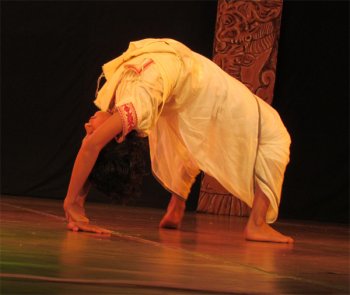 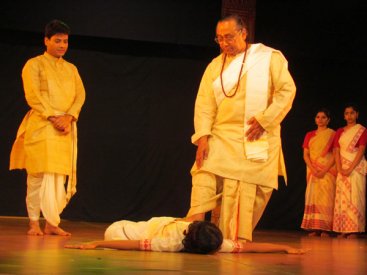 Correcting the posture 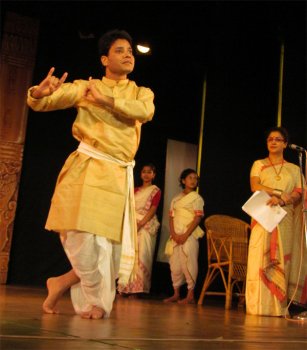 Naren Chandra Baruah 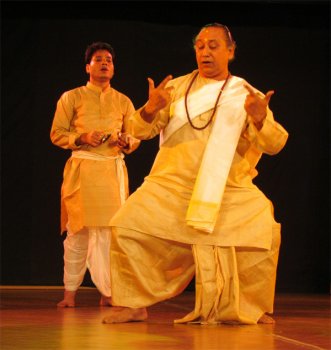 Guru Manik Bora Barbayan Sattriya dance is based on Natya Sastra, Abhinaya Darpana and Srihasta Muktavali. The basic exercise and grammar of Sattriya dance called “mati akharas” lay the foundation in the training of a Sattriya dancer, and form the first lessons to correct postures. They even serve as exercises. The demo reminded us of a Kathakali guru giving body massage to his student, but in this instance, it was to correct the posture. The mati akharas are further sub-divided into eight main types - Ora, Saata, Jhalak, Sitika, Pak, Jap, Lon and Khar. Ora is like the Bharatanatyam araimandi or Odissi’s chowk position. After that, angya (limb), pratangya and upanga (lower limb) exercises are taught followed by hastas and drishti bedas. Gayan bayan (orchestra) is performed at the beginning of Ankiya Nat (Ankiya means "act" and nat means "drama"), created by Sankaradeva who was an ardent devotee of Krishna. The Bhakti movement inspired the Ankiya Nat and all the plays in the repertory of this theatre are one-act plays. There are 36 talas in Sattriya tradition. There are male and female dance numbers in Sattriya and most dance numbers are divided into 3 parts or 2 parts. The main dancer Naren Chandra Baruah, the young boy and 2 female dancers demonstrated male and female dances, typical male and female movements, jump, twist, jump in Ora stance, embrace, peacock and tortoise etc that reminded one of Gotipua movements. Oja Pali (meaning leading dancer and supporter) performed by a group of chorus singers and dancers, highly influenced the Sattriya dance tradition. Oja Pali focuses on the stories from the epics and Puranas. In the well planned lec-dem, Guru Manik Bora Barbayan himself demonstrated some points to much appreciation and left the audience wanting more! When we heard that a large 30 member Chhau troupe was in town for the NKC, we did wonder why and that only sponsorship by Sangeet Natak Akademi could have made it possible. The large contingent of dancers and musicians was headed by Guru Shashadhar Acharya. The wondrous morning featured 3 sets of dancers, 3 sets of musicians and was beautifully planned to showcase all 3 Chhau styles of north eastern India. The nuances of Mayurbhanj Chhau (Orissa), Seraikella Chhau (Jharkhand) and Purulia Chhau (Bengal) were explained by dancer Shagun Bhutani and Shashadhar Acharya. Propagated by erstwhile nobility, who themselves taught and performed, Mayurbhanj and Seraikella Chhau had royal patronage while Purulia Chhau was sustained by the people themselves. The teachers were males and taught in open arenas called akhadas. Using indigenous drums like dhol, dhumsa, nagada and kharka, and the soulful shehnai/mohuri and flute, Chhau was used for ritualistic ceremonies of birth, marriage and death. Chhau was originally popular in 36 states, starting from one state and spreading through Chaitra Parba, the famous local festival that is still popular. 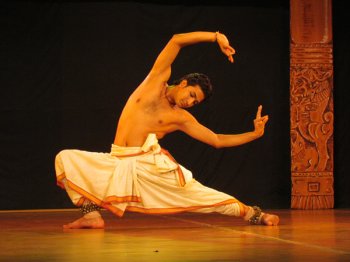 Seraikella Chhau 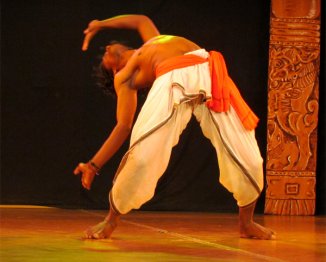 Mayurbhanj Chhau 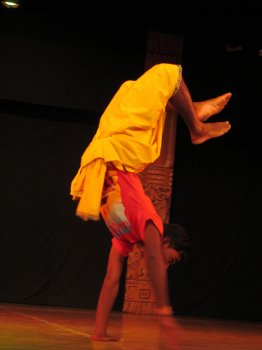 Purulia Chhau 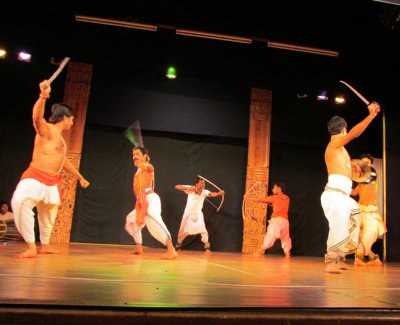 Mayurbhanj, Purulia, Seraikella There’s a palpable connection between Mayurbhanj and Seraikella Chhau, especially the symmetrical chowk stance. All dancers need to do basic exercises to improve flexibility, balance and relate movement to rhythm. The repertoire is inspired by nature, mythology and the culture of the region. The 4 sections of Chhau are chali, ufli, khel and bhangima. The pranam (pharikhanda style of saluting with the sword); movements inspired by surrounding nature called topkas or chalis (stylized gaits of peacock, elephant, snake, crane, butterfly); uflis (the movements of the body, limb and foot work with leap and motion) that are modeled on daily chores are 18 each for male and female – feminine household activities like sweeping the floor, sprinkling cow dung mixed with water, removing small stones from the floor, wiping the floor, pounding the rice, removing the husk and so on; masculine activities abstracted from farming, hunting, fishing; monkey or tiger drinking water, crane catching a fish, a jumping goat etc. Demo of all these in the 3 styles was greatly enjoyed by the audience. Khel / ruk-mar (mock combat techniques) is based on attack and defense movements from the martial arts tradition of pharikanda (shield and sword). Weapons are even worshipped on Vijayadasami day. Some types of sword play were demonstrated. Bhangimas or gestures are used by various characters and generally female gestures are practiced in bhangimas. 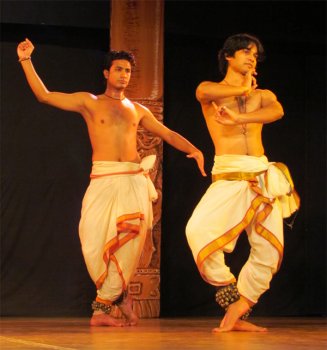 Male and female roles in Seraikella Chhau 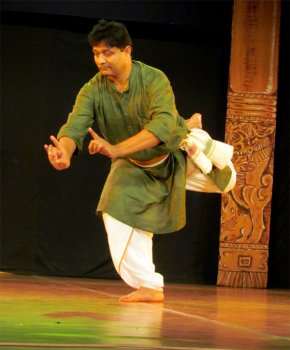 Guru Shashadar Acharya After technique, the bol section showed how bols change the character or sentiments of an item, and the difference in structure of bols for male and female dancers. Bols introduced by gurus have now changed, some items have bols, some don’t. There’s a pre-akhada, akhada and post akhada phase to Chhau. From 1205, the form has undergone many changes, as has the music. Chhau rhythms are the prana of dancers and Shashadhar Acharya demonstrated the rhythms as well as sang some songs in his rich voice - the Oriya songs in the 18th century and Bengali songs for Purulia style that drew its themes from the epics Ramayana and Mahabaratha. In 19th century, Hindustani ragas like Desh, Yaman, Charukesi, Saraswati, Peelu, Miya ki Malhar etc came into Mayurbhanj and Seraikella Chhau. No discussion on Chhau is complete without reference to the masks. Detailed makeup is used in Mayurbhanj Chhau. Seraikella and Purulia Chhau use masks but the physical appearance and manner in which they are used differ. In the absence of mukhabhinaya as the face is hidden behind the mask, the body has to convey the story. While Seraikella masks are influenced by Patachitra and are delicate, Purulia masks are inspired by Kali pooja figures and are more colorful. The identity of the dancer gets concealed and the mask takes over. Many performers are seventh generation artistes but the art does not sustain them, so they are into mundane jobs while their art sustains their energy. The screening of a 10 minute film made by Sangeet Natak Akademi for UNESCO that helped select Chhau in 2010 as an intangible oral heritage rounded up the Chhau demo. It was amazing to see aged gurus perform energetic acrobatic moves. The whole session was marked with martial art fervour, resounding drum beats and super acrobatics and speed of Purulia Chhau performers. After the valedictory speech by Shanta Dhananjayan, Nalini Raghu and Rajyashree Ramesh were awarded the best prize for their articles on teaching in 2010 NKC souvenir. Priyadarsini Govind was announced as the convener of NKC 2012. Every session was unique and we learnt a lot about every style, realizing that what looks easy or slow on stage are deceptively simple and actually involve so much hard training! “Just when you think you know everything about a dance form, you find yourself humble after watching these lec-dems. There’s a great deal more to learn,” said critic Leela Venkataraman. The 2 years of NKC based on Abhyaasa Sampradaya was indeed a great learning experience for not only the lay person but dancers, gurus, writers and dance scholars. As we celebrated successful completion of the conference with lunch at the Krishna Gana Sabha canteen, Guru Dhananjayan was happy that dancers from across the world had benefited from the learning sessions, but expressed his disappointment that though it was a very well attended conference, hardly any local dancers or gurus had put in an appearance. More images Lalitha Venkat is the content editor of www.narthaki.com Comments Lalitha Venkat, Content Editor of Narthaki, has done a commendable job in giving an exhaustive report on the 31st Naatya Kala conference. This will benefit those who did not attend the conference. The participants are so happy to see the Narthaki online report and their pictures. I personally thank Lalitha Venkat - who is also a member of NKC advisory council - for attending every day of the conference and meticulously writing this report. We thank Narthaki in particular for doing such a wonderful contribution to the performing arts world. Kudos to Anita Ratnam for her service and keen interest in bringing hearts together through art. Narthaki is the best link to the art world. All the best. Shanta Dhananjayan (Convener 31st Naatya Kala Conference) January 4, 2012 |